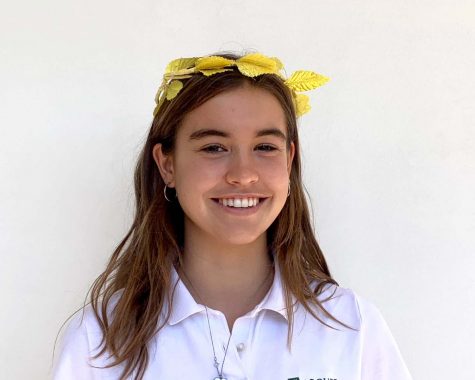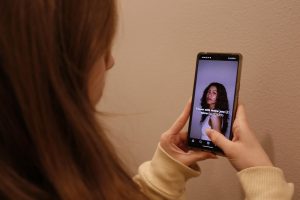‘A fruitful endeavor:’ The upper school puts on virtual performance of ‘The Drowsy Chaperone’
Photo credit: Greta Irvine
Upper school students watch a performance from the musical, “The Drowsy Chaperone,” on May 6 via Zoom. The students had the chance to preview the upper school musical and purchase tickets for streaming the following night at 7 p.m. “I was really, really impressed with how the whole production came together…and I am proud of the hard work put into it as well,” Isabelle Verdery (’23), who was cast as Janet, said.
May 24, 2021
Four months after conducting virtual auditions for the upper school musical, the cast stepped onto the screen to perform the “The Drowsy Chaperone.” Emulating past productions of the year, the musical was streamed to the Archer community as a pre-made video on May 7 using the platform SHOWTIX4U. Director Reed Farley reflected on the “joy [of] the process” while watching the production come together on screen.
“Ambition was built into the project…I’m really proud that we all stayed calm and we had fun,” Farley said. “We didn’t stress over what wasn’t working — we focused on what was working and by doing that, I always left rehearsals happy. I’m just really thankful for the time I got to spend with those performers.”
The musical fused the classic plot of “The Drowsy Chaperone” with an Archer twist. The traditional plot follows a musical theatre fan in his apartment as he reminisces about his favorite musical that plays on a nearby record player. As the record player spins, the musical comes to life in his room. The revised, Archer version of the musical strayed from the standard lead character, Man in Chair, according to Anaiya Asomugha (’24), who was cast as (Wo)man in Chair.
“I liked how my character didn’t have a set description so that we could alter her,” Asomugha said. “I liked how the system worked at Archer theatre where things could always be modified to [my] comfortability as an actor.”
The lead character, modified from a middle-aged man in his apartment to a college-age girl in pandemic isolation, was developed through a joint effort among the cast and crew.
“We collaborated with our assistant director and the performer playing the role,” Farley said. “We knew we wanted — instead of the man in the chair — a girl in isolation and being college-age made sense to us. Then, Anaiya brought Berkeley to the table because that was a school that resonated to her and so she ran with that. I was really proud of [Asomugha] for embodying that character…[I was] proud of how she interpreted it and created reality out of it.”
As the final upper school production of a remote year, the musical paralleled the all-virtual process of past productions. Auditions began in January, followed by rehearsals, which took place over Zoom. The 25 person cast and 15 person crew virtually assembled after school for the months leading up to May and engaged in rehearsals deviating from past in-person structure.
“Rehearsals were just very different,” Isabelle Verdery (’23) who was cast as Janet, said. “It taught me a lot about how I work as a person — that although independent work isn’t what I’m used to in theatre, I was able to be flexible.”
The expansion of independent work during rehearsals was formulated based on knowledge gained from directing previous productions of the year, according to Farley.
“I knew what we needed [during tech week], and I knew what we needed after school so kept rehearsals a lot shorter to combat the Zoom fatigue we all had,” Farley said. “But what that required was more asynchronous work on the part of the actors … However, I really appreciated their autonomy, and I think everything on the screen was a result of their hard work.”
Along with adjusted rehearsals, Farley noted that costume and set design had to be adapted to the online space. As opposed to sending home green screens and editing in backgrounds over video clips, the production made use of the spaces within the actors’ homes.
“We utilized natural environments to give [the musical] a more cinematic feel. I thought it was a great way to add more visual interest,” Farley said. “I collaborated with the actors for some scenes where we would look for spaces in their homes and art direct the placement of props in their own spaces…so it was collaborative in the end.”
Song production proved difficult for the cast and crew, as each actor was responsible for producing audio recordings, which were then synched together to imitate the sound of a group performing on stage. Stage manager Lily Kerner, who was in charge of receiving and organizing the audio clips, said she learned more about patience through this process.
“One of the big challenges was that everyone has rotating schedules, and sometimes actors just didn’t want to record songs right after rehearsal, so that made it really difficult to get all the vocal recordings on time,” Kerner said. “That meant I had to send out somewhere between three to four mass emails per day, and that’s just about communication…but it [was] doable.”
A main aspect of theatre that could not be “completely replicated online” was acting, according to Asomugha.
“I found it a little hard because we could only see from waist up, and usually when I’m acting I like to look at everybody’s body because even the slightest move means something for a character,” Asomugha said. “But what I could get was people’s facial expressions, and the girls were really good at communicating through that.”
Farley noted two other prominent challenges during the production process, both being a result of the virtual space: Shooting scenes with live reactions between actors required finding a platform that could record actors simultaneously and synching the video footage with the vocal pre-recordings was an extensive task to complete.
Despite the challenges of the production, a successful feature was the suitable genre of the musical for the virtual setting.
“Choosing a lighthearted comedy was very smart,” Verdery said. “While acting on Zoom, a lot of things get lost through recording remotely so you have to act bigger, more flamboyant and fun, and that fit the comical characters well.”
Asomugha and Kerner both recognized the value of connection that transpired between cast and crew members during the production process.
“Archer theater will always be a very close-knit community,” Kerner said. “I think that being able to socialize before rehearsals and after and throughout especially tech week was extremely fun and nice to see. I just love the theater kids — they’re just the best and they support one another and give it their all. At the end of the day, that’s what matters.”
As the year comes to a close, Farley looks to the future of Archer theatre productions.
“I missed the in-person piece of it, however, the students found the intrinsic motivation to give their best performances, and I think that’s because we’re a healthy theatre community,” Farley said. “This was just one musical that got done remotely…and the performers — they will be able to take everything that brought them to this moment and apply it next year on a stage. I think the students are really going to be ready to shine.”









